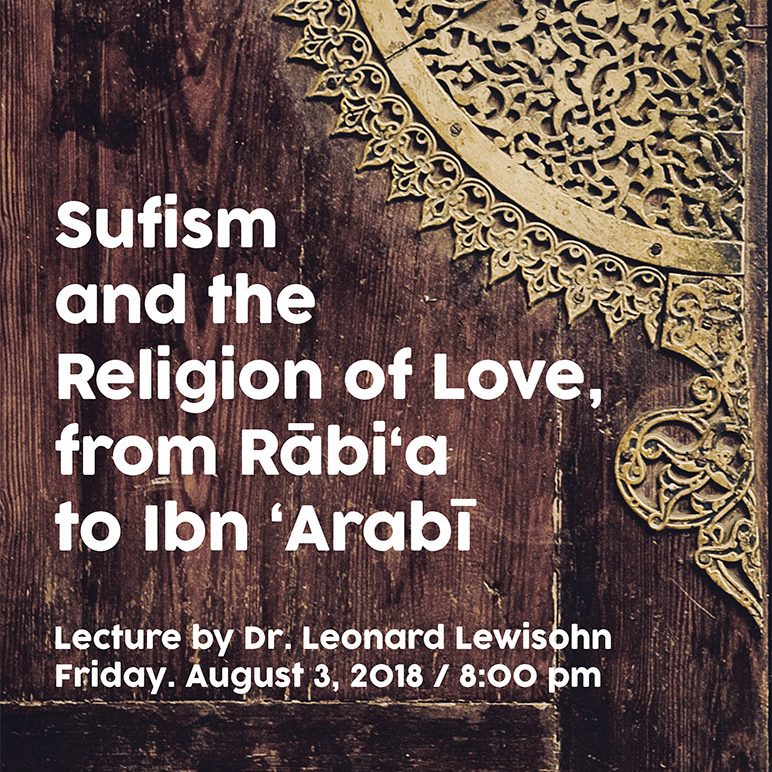Sufism and the Religion of Love, from Rabi‘a to Ibn ‘Arabi
Lecture by Dr. Leonard Lewisohn
Friday. August 3 / 8 pm
$15 – Tickets will be available at the door – Doors will open at 7:30 pm
One day in pre-eternity a ray of your beauty
Shot forth in a blaze of epiphany.
Then Love revealed itself and cast down
A fire which razed the earth from toe to crown.
– Hafiz
“The religious conscience of Islam is centred upon a fact of meta-history” wrote Henry Corbin, referring here to the pre-eternal covenant mentioned in the Qur’an (VII: 172), where God asks the yet uncreated souls of Adam’s offspring, “Am I not your Lord?” and the souls in their pre-creational state, reply: “Yes (bala),” thus acknowledging Him as their Lord. The entire mythopoetic romance of Sufism developed out of this primordial, pre-eternal covenant (mithaq) between man and God. Apropos of this verse, one of the later theoreticians of the Sufi erotic religion (Ruzbihan Baqli, d. 606/1210) was thus to comment how “the spirits of the prophets and saints became intoxicated from the influence of hearing the divine speech and seeing the beauty of majesty. They fell in love with the eternal beloved, with no trace of temporality.” Referring to another Qur’anic verse: “He loves them and they love Him” (V: 54), another Sufi theorist, Ahmad Ghazali (d. 520/1126), would compare God’s love for mankind (“them”) to a seed sewn in pre-Eternity sprouting up in the tree of “they love Him.” There is only one love that pervades the hearts of men according to Ghazali, for all love is ultimately spiritual, all love ultimately originating in the “Spirit’s Court.”
Sufis know that to experientially apprehend God’s love for humankind one must practice works of devotion, leading to “proximity caused by supererogotative works of worship” (qurb al-nawafil), as encapsulated in the famous hadith qudsi, often referred to as the hadith of ‘intimacy with God’: “My slave draws near to Me through nothing I love more than that which I have made obligatory for him. My slave never ceases to draw near to Me through supererogatory acts until I love him. And when I love him, I am his hearing by which he hears, his sight by which he sees, his hand by which he grasps, and his foot by which he walks. And when he approaches a span, I approach a cubit and when he comes walking I come running.”
The idea of God’s pre-eternal love passionate love (‘ishq) expressed in this hadith, the above-cited verses as well as many other passages from the Qur’an, infiltrated the spirituality of Islam from the very earliest period. In this lecture I will sketch the basic contours of the theories and doctrines of Sufi erotic theology and the religion of love in the Qur’an and Hadith. Based on numerous references to the Muslim scripture, five key themes eventually evolved—Pre-eternal Love and Beauty, Salvation through Love, Love of Beauty, Charity and Love of one’s Neighbour, and Romantic Love/Erotic Love—into fundamental topoi of what later became known as the ‘Religion of Love’ (in Arabic: din al-Hubb; in Persian: madhhab-i ‘ishq) in Sufism.
My discussion of love in the Sufi tradition commences with the love mysticism in the Qur’an followed by a survey of the thought of one of the key founders of early Sufi ascetic theology, Rabi‘a Adawiyya (d. ca. 162-176/788-92), who figures as supreme mistress of the Sufi religion of love, before chronologically surveying the Sufi theosophy of Eros and the erotic in Sufism over the ensuing five hundred years. The talk ends with the final blossoming and culmination of Islam’s ‘religion-of-love mysticism’ in the thought of Ibn ‘Arabi (d. 638/1240). Lastly, several pages of examples (provided in handouts) of how topoi relating to the ‘Religion of Love’ was illustrated in verse by some thirty odd classical Persian poets, from Humam-i Tabrizi (d. 714/ 1314) to ‘Abd al-Rahman Jami (d. 898/1492) will be discussed.
Dr. Leonard Lewisohn is Senior Lecturer in Persian and Iran Heritage Foundation Fellow in Classical Persian and Sufi Literature at the Institute of Arab and Islamic Studies of the University of Exeter in England where he currently teaches Islamic Studies, Sufism, history of Iran, as well as courses on Persian texts and Persian poetry in translation. He specializes in translation of Persian Sufi poetic and prose texts.
He is the author of Beyond Faith and Infidelity: The Sufi Poetry and Teachings of Mahmud Shabistari (London: 1995), and the editor of three volumes on The Heritage of Sufism, vol. 1: The Legacy of Mediæval Persian Sufism, vol. 2: Classical Persian Sufism from its Origins to Rumi Classical Persian Sufism from its Origins to Rumi, vol. 3 (with David Morgan): Late Classical Persianate Sufism: the Safavid and Mughal Period (Oxford: 1999)—covering a millennium of Islamic history.
He is editor of the Mawlana Rumi Review, an annual journal devoted to Jalal al-Din Rumi (d. 1273). He is also editor (with Christopher Shackle) of The Art of Spiritual Flight: Farid al-Din ‘Attar and the Persian Sufi Tradition (London: I.B. Tauris 2006), co-translator with Robert Bly of The Angels Knocking on the Tavern Door: Thirty Poems of Hafiz (New York: HarperCollins 2008), editor of Hafiz and the Religion of Love in Classical Persian Poetry (London: I.B. Tauris 2010), and editor of The Philosophy of Ecstasy: Rumi and the Sufi Tradition (Bloomington, Indiana: World Wisdom 2014), and co-editor (with Reza Tabandeh) of Sufis and Mullahs: Sufis and their Opponents in the Persianate World (forthcoming 2018).
Dr. Lewisohn has contributed articles to the Encyclopedia of Love in World Religions, Encyclopedia of Islam (2nd and 3rd editions), Encyclopædia Iranica, Encyclopædia of Philosophy, 2nd Edition, Encyclopædia of Religion, 2nd Edition, Iran Nameh, Iranian Studies, African Affairs, Islamic Culture, Journal of the Royal Asiatic Society and the Temenos Academy Review.
